
|   |

|   |
Indian Independence Day celebration in Washington DC - Manjari Sinha e-mail: manjari@sinha.com Photos: Manjari Sinha September 3, 2024 The Embassy of India, Washington D.C. and Indian Performing Arts Promotions (IPAP) with the John F. Kennedy Center for the Performing Arts, Washington D.C, celebrated the 78th Indian Independence Day on the 18th of August with a Mayurbhanj Chhau dance performance by Rajesh Sai Babu and his dance company, the 'Gurukul Chhau Dance Sangam' from India at the Kennedy Centre. It was for the first time that this tribal martial dance form was being performed in the US and that too at this prestigious venue. In 1912, when King George V visited India, the erstwhile Maharaja of Mayurbhanj, Odisha had organised a Mayurbhanj Chhau performance to welcome him. One hundred and twenty years later, UNESCO announced the Chhau dance to be added to the 'Intangible Cultural Heritage of Humanity'. Dance lovers at the Terrace Theatre of Kennedy Centre were excited to learn this from Pratap Das of IPAP when he invited Mr.Jagmohan from the Indian Embassy for his speech on this occasion. Wishing the audience a 'Happy Independence Day', Jagmohan introduced them to India's rich cultural heritage which is usually witnessed here in the US through Indian classical music or dance like Bharatanatyam, Kathak or Kathakali et al, but it is also represented through her folk and tribal dances like the Mayurbhanj Chhau dance being presented this evening to celebrate the Indian Independence Day, he remarked. The tribal Chhau dance in general and the Mayurbhanj Chhau dance in particular are known for their robust and powerful body movements. It is a vibrant and dynamic dance form of martial arts that originated in the Eastern parts of India. Rajesh Sai Babu is trained in Mayurbhanj Chhau dance under his father Guru Janmejoy Sai Babu. Alongside his father and brother, Rajesh has led the dance company 'Gurukul Chhau Dance Sangam'. This special program featured a group of nine dancers trained by Rajesh Sai Babu in the artistry of vigorous jumps, spins and high kicks, contrasted with subtle movements of the torso and shoulders. 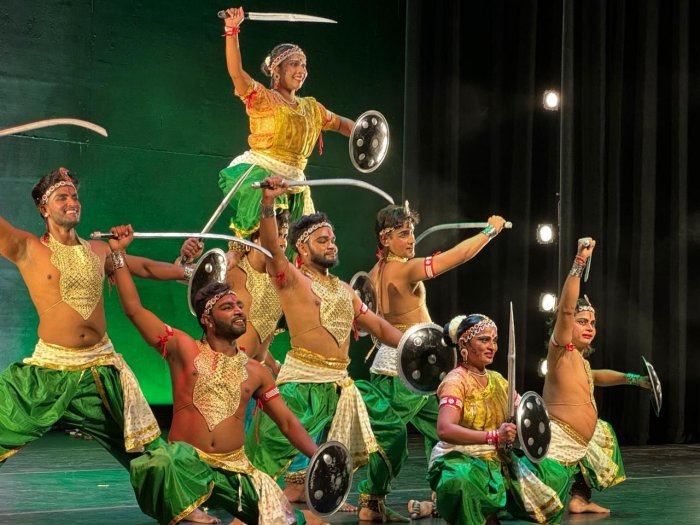 Anokhe Bharat Ke Yoddha Rajesh Sai Babu and his team of talented dancers took a flying start with 'Anokhe Bharat Ke Yoddha' (the courageous warriors of India), based on the patriotic song "Bharat Anokha Raag hai", keeping in mind the occasion of India's Independence Day. The song unveiled the soul of India with her serene beauty and underlying strength, honouring the warriors with the graceful martial arts movement of this dance form. The 'Hathiyar Dhara' technique of Mayurbhanj Chhau was imaginatively used by the choreographer Rajesh Sai Babu using spears, swords and the 'Dhanush Baan' etc to bring alive the valour of India's warriors. The striking shoulder and torso movements evoked bravery with grace. Dancers holding the saffron, white and green lengths of silken cloth sailing all over through their vigorous movements filled many in the audience with patriotic fervor. 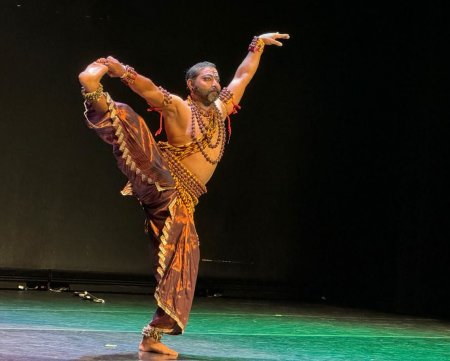 Rajesh Sai Babu in 'Nataraj' 'Nataraj', the impressive solo by Rajesh Sai Babu next, was an ode to the God of dance Nataraj. The authentic Chhau dance vocabulary brought alive Shiva's attributes and his prominent moods like yogic and peaceful in the state of preservation, the frenzy of destruction while killing the demon of ego and ignorance, and the ecstatic blissful state while recreating the universe. Rajesh strikingly enacted Nataraja's attributes like Trinetra, with his third eye burning with fury, 'Neelakanth', the one with a blue neck after drinking the poison and blissful one using both the tandav and lasya ang shown through vigorous and graceful body movements of Chhau with authentic Chhau music on instruments like the mahuri and the dhol, conspicuously missing in the first item. The Ganesh Stuti 'Gajavadana' was a group presentation invoking the elephant-headed deity symbolising wisdom. This was again performed on a recorded Arati song of Ganesha where the authentic Chhau music was conspicuous by its absence. The music was appealing, opening with the pakhawaj which is the favourite musical instrument of Lord Ganesha. Dancers Pritha Ghosh, Aditya Shrivastav, Neeraj Malik, Sumit Mandal, Jai Singh and Ramhari Mohanta did full justice to the devotional song. 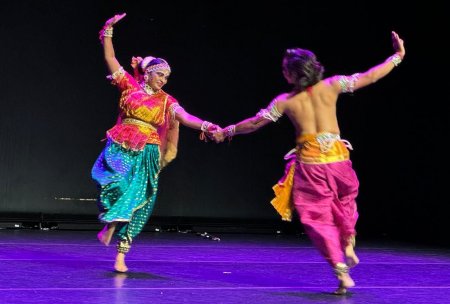 Kamadev-Rati 'Kamadev-Rati' set against the backdrop of nature's rejuvenation in the spring season was a captivating group dance with Neeraj Malik as Vasant Ritu, Ramhari Mohanta as Kamadev and Laxmimani Mohanta as Rati. The choreography for the trio depicted nature's bounty in the spring season that brings forth Kamadeva, the deity of love, attracted towards the irresistible beauty of Rati moving amongst the fluttering butterflies on multihued flowers. The narrative of Shringar Rasa was brought to life with Kamadeva's eloquent proposal to Rati, and her consent to dance together in amorous unison. The shehnai like auspicious sound of the mahuri (the tribal wind instrument) enhanced the celebratory ambience with the dhol. 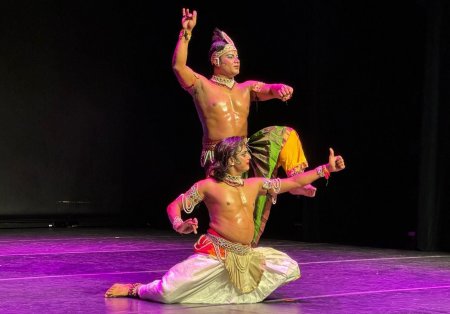 Krishna & Arjuna in Geetopadesh This was the perfect crescendo for an intermission after which the mood changed with 'Geetopadesha' heralded with the sound of conch shell. This was from the epic Mahabharata condensed in Bhagavad Gita, where the Pandavas and Kauravas are assembled in the battleground to engage in war and Arjuna refuses to pull a weapon to kill his kins. Lord Krishna, who was his charioteer, reveals his divine self and preaches Jnana yoga to Arjuna explaining the inevitability of the situation which could be dealt with only through the Karma Yoga, following his duty as a warrior. Ramahari Mohanta and Sumit Mandal enacted their respective roles with aplomb. 'Durga and Kali' next was a powerful ode to the feminine energy epitomised by Devi Durga, the Mahishasura Mardini who killed the demon Mahishasura and to Kali, who killed the indomitable Raktabeej, the demon who could replicate himself from every drop of his blood. The mythological stories of the two goddesses revered for their strength, courage and righteousness underlined the triumph of good over evil. Dancers Pritha Ghosh and Atif Khan as Durga and the Mahishasura in the first duet and Laxmimani Mohanta and Ramhari Mohanta in the second; were convincing. 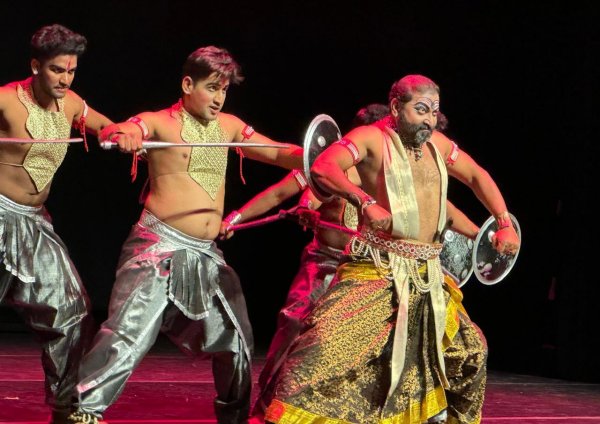 Ravan The evening reached its climax with 'Ravan', the multi-dimensional character from the epic Ramayana who is often portrayed as the formidable villainous king of Lanka, but who was also a learned Vidwan of Shastras and a great Shiva Bhakta (devotee of Shiva). Rajesh Sai Babu, as the mighty Ravan and other dancers like Atif, Aditya, Sumit and Jai assisting him brought alive the complexity of his character full of human virtues and vices. The glimpses of 'Shakti Pooja' (prayer to Shakti, the female deity or divine energy) by Rama invoking the Devi and the Shiva Tandava Stotra by Ravan invoking Shiva before the Rama-Ravan Yuddha, added intensity to the striking verve of the crescendo. Rajesh Sai Babu, the team leader conceived and choreographed the entire Mayurbhanj Chhau presentation. Credit also goes to the light designer Ramesh Jena, the sound designer Paresh Parekh and the anchor Manjula Kumar for her articulate introductory remarks for every item but for her repeated mispronunciation of Chhau as Cho and Rajesh Sai Babu as Baba. The US tour of the Mayurbhanj Chhau dance troupe of Rajesh Sai Babu was sponsored by the Battery Dance Company of Jonathan Hollander, New York. 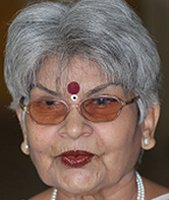 Manjari Sinha has an M.A. in Sanskrit and Music, and Sangeet Prabhakar in vocal, tabla, sitar and Kathak dance. She has regular columns in national dailies as a music and dance critic. |